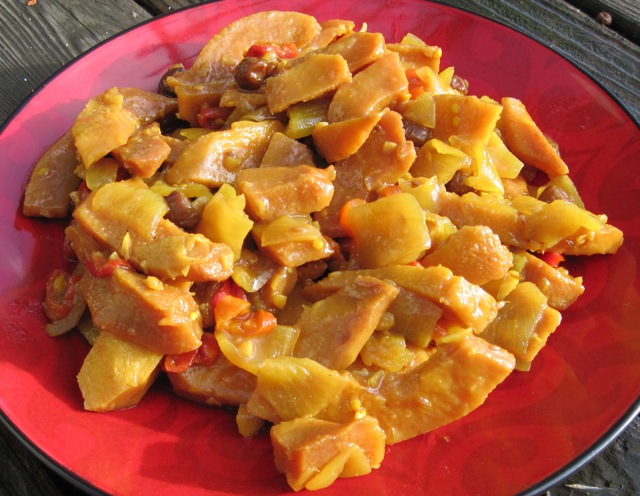
primary-image, l
(post, Linda Ziedrich)

primary-image, l
Finally I am running out of quinces. I have two trees, of the variety called Pineapple, and they produce more reliably than any of the apple, pear, plum, and cherry trees in my lowland orchard. So I always give away quinces, and this year I even sold some. Yet it’s January 20, and still I have a box of the fruit left in the unheated guest bedroom. I’m not complaining. Quinces are good for a lot of things. From the nineteenth century until after World War II, quinces were valued especially for their pectin. People would cook the sliced fruit in water, and then either make the liquid into jelly or boil it down until it was sour and viscous before combining it with other fruits in jelly or jam. For centuries before that quinces were made into paste, the original marmalade—or, simply, thick, sliceable jam—to be served as finger food. Quince paste has never lost popularity in Spain or parts of Latin America, and it seems to be coming back into style in the United States. Even more appealing than quince paste, to me, are pastes from quinces combined with other fruits, such as berries and plums. Quinces also make delightful, fragrant syrups (I most like a raw syrup of quince and honey), and jams that can turn out red or white, and smooth or rough, depending on your method. Cooked in syrup for nearly two hours, quince cubes or slices become a ruby-red spoon sweet. Steeped in vodka with sugar, quinces become an aromatic liqueur. Poached in white wine with honey, they become a tart relish for roasts or even a dessert. Quinces combine well with apples in pie, and some people like them best simply hollowed out (with a coring tool that looks like a small, heavy spoon with a pointed tip) and baked whole like an apple. Having made all those things this year, I wanted to try something different. I gazed at the quinces, sitting in the guest bedroom beside the last of the peppers (peppers keep much longer in a cool guest room, by the way, than they do in a refrigerator), and I wanted to combine the two. I’d already made some wonderful quince–red pepper jelly. What else could I try? I decided on— Quince Chutney 1 to 2 tablespoons mustard oil (see Note) 3 tablespoons chopped garlic 1 teaspoon cumin seeds 1 pound peeled and sliced or diced quinces 1 teaspoon ground turmeric 1 cup cider vinegar 1/2 cup brown sugar 1 medium-large (about 1/2 pound) onion, halved and sliced thin 2 ounces small fresh hot red peppers (I used jalapeños and Fresnos), sliced thin 1 1/2 teaspoons chopped gingerroot 1 teaspoon salt 1 3-inch cinnamon stick 2 tablespoons raisins Heat the oil in a preserving pan. Add the garlic and cumin seeds, and stir them over medium heat until they release their aroma. Immediately add the remaining ingredients. Boil the mixture gently, uncovered, over low heat, stirring occasionally, until the liquid is absorbed and the quince is tender, 1 1/4 to 1 1/2 hours. When the quince has cooled, store it in a covered container in the refrigerator. Note: Available in Indian markets, mustard oil is always labeled in the United States as “for external use only.” The USDA requires this labeling because the oil contains erucic acid, which is said to cause “nutritional deficiencies as well as cardiac lesions” in lab rats (mustard seeds and prepared mustard also contain this natural chemical, of course). Mustard oil has a very strong flavor. If you’re not sure you like it, use only 1 tablespoon. If you’re sure you don’t like it, or if none is available, substitute another oil. This recipe is actually a variant of one I developed for apple chutney, and that chutney turned out equally delicious. So if your guest bedroom is filled with apples rather than quinces, this is a good way to use them.